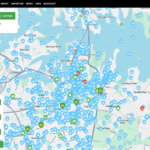Politicking by Labor and the Greens risks eroding the independence of the Reserve Bank, an economist has warned.
The RBA yesterday held its nerve and kept interest rates at 4.35 per cent, as the Greens demanded a rate cut and the government was accused by bank governor Michelle Bullock of dining out on a temporary energy relief subsidy.
Figures released today showed the annual rate of headline inflation fell to 2.7 per cent in August, down from 3.5 per cent in July, putting it within the RBA’s preferred 2-3 per cent target band.
The Greens had earlier withdrawn support for the Treasurer’s proposed reforms of the RBA in an attempt to pressure Treasurer Jim Chalmers to intervene and reduce rates.
“For weeks the Treasurer has acknowledged the economy is being smashed, and that mortgage holders are being smashed by high interest rates – yet to date he’s done nothing about it despite having the power to reduce interest rates,” Green’s Senator Nick McKim said.
But, economist Mengheng Li disagreed, calling the proposal illogical.
“The Greens’ position is all but a rational or even logical one,” said Li, a senior lecturer at UTS Business School. “It demonstrates irresponsible politicking.
“It aims to put the RBA into political debate, while in fact a central bank should and must remain a high degree of independence in monetary policymaking.”
The Coalition removed support for Chalmers’s proposed reforms, which would allow a separate board of the RBA to set interest rates, with decisions made by appointees of the treasurer.
Shadow Treasurer Angus Taylor cited concerns Chalmers would be appointing board members too closely aligned to Labor, which forced him to look to the Greens for support of the bill.
The majority of economists were in agreement on Tuesday over the RBA holding firm on rates, while Dr Li said the economy could not withstand reducing the cash rate at the current time.
The better-performing US Federal Reserve cut interest rates last Wednesday by half a per cent, noting: “Inflation has made further progress toward the 2 per cent objective but remains somewhat elevated.”
Inflation in the US is 2.9 per cent compared to 3.8 per cent in Australia. In 2022, it peaked at 9.1 per cent in the US while Australia saw a high of 7.8 per cent.
Around the end of this year, the RBA should cut rates, not as big as the US one, but in a controlled way that does not fuel the housing market.
In a statement yesterday following the rate announcement the RBA board said: “Underlying inflation has been above the midpoint of the target for 11 consecutive quarters and has fallen very little over the past year.”
Shifting in the cash rate between the two economies, however, will increasingly become a factor the RBA will have to consider said Dr Li.
“As the interest rate difference widens, there will be more domestic pressure due to AUD appreciation,” he added, because Australian assets like bonds become more attractive from a foreign perspective — paying more interest and creating demand for Australian dollars.
“[The] interest rate and output gap are closing, but still positive. The downward movement in both gaps will slow down as the Fed lowers the rate.”
A positive output gap means economic output is operating above the amount required to maintain the RBA’s inflation target. When the difference between the US rate and Australian rate changes and increases the value of the AUD, among other factors, it can contribute to a reduction in foreign demand and an increase in domestic demand for imports as Australian products become less competitive globally due to higher prices and Australians’ purchasing power increases.
“As it manifests, say around the end of this year, the RBA should cut rates, not as big as the US one, but in a controlled way that does not fuel the housing market, especially shelter inflation,” Dr Li said.
Since the Federal Reserve reduced rates the value of the Australian dollar has increased by 1.37 per cent.
Chalmers is legally able to override RBA decisions to meet Green demands by using Section 11 of the Reserve Bank Act, something never done by an Australian Treasurer before.
But economists warn this precedent could be dangerous for the future of the RBA, forcing it to deliver “long and pointless justification for any type of internal reforms or non-interest rate policies at the RBA”.
“As an open economy, discussion like this slows down the effectiveness of the RBA’s actions, causing a disparity between the automatic adjustment in the goods market and the money market,” said Dr Li.
Despite this he said he is encouraged by the proposed reform, describing it as “an act that means to improve the transparency of RBA’s monetary policymaking and its credibility”. RBA Governor Michelle Bullock also supports the reforms.
Household debt in Australia is 214 per cent compared to disposable income, which is significantly higher than that in the US. Bullock said earlier this month that some Australians will have to cut spending, increase work hours and sell their homes.
As we close in on a possible Federal election next year, a Roy Morgan poll on Tuesday showed that if the election were held today, it would be ‘to close to call’ with the cost of living remaining a key issue for voters. The reduction of the cash rate with Chalmers at the wheel may be required to get the ALP over the line.
Main image by Gencraft AI.




























